Tsuktiben Jamir
Despite having hands and feet that resembled those of modern humans, Homo naledi, a hominin found in the Rising Star cave system in Africa’s Cradle of Humankind, had a brain that was just one-third the size of a modern human, a trait that experts had previously ascribed to a sign of the species’ lower intellect than its Homo sapien ancestors.
Speleologists Rick Hunter and Steven Tucker were the ones who made their initial discovery of an exceptional collection of these hominid fossils on September 13, 2013. The cave has so far yielded the remains of over 15 members of an extinct human species that has been given the name Homo naledi. Between 335,000 and 241,000 years ago, these little, small-brained distant relatives were likely to have inhabited Southern Africa.

Courtesy: Mark Thiessen/National Geographic.
Three recently released studies assert that Homo naledi, a species distinct from Homo sapiens, engaged in intentional burial practices—a sophisticated custom typically associated with our species, Homo sapiens. These studies also propose that Homo naledi created rock art, implying the presence of advanced cognitive abilities. Nevertheless, as archaeologists devoted to studying the early humans of Africa, we maintain some reservations regarding the validity of these new findings, as they argue that the evidence put forth in the studies is not compelling enough to support such ground-breaking conclusions. Hence, we have yet to be fully convinced by the research.
It is unknown if Homo naledi and Homo sapiens, which would have coexisted at the same time approximately 250,000 years ago, ever interacted. To ascertain whether there are any parallels to humans, scientists are still examining the molecular biology of the remains.
To date, the earliest unequivocal proof of deliberate burial practices in Africa stems from excavating the Panga ya Saidi cave site in eastern Kenya. A research team meticulously examined this site, and through rigorous analysis, its age was determined to be approximately 78,000 years old. Within this context, a burial was discovered, precisely that of a Homo sapiens child, which satisfies the stringent criteria established by the scientific community for identifying intentional human burial.
The alleged burials do not fulfil a crucial criterion for intentional burials: the anatomical alignment and articulation of skeletal remains. The body typically remains intact in a deliberate burial, with minimal displacement attributed to decomposition. This preservation of anatomical integrity is achieved by promptly covering the body with soil during burial. However, a significant obstacle to verifying the validity of these findings is that none of the alleged burials have undergone thorough excavation. As a result, it is impossible to assess the completeness of the bodies, their original positions, or the extent of the proposed burial pits.

Courtesy: ABC7 News.
One of the publications made an equally bold assertion regarding Homo naledi, stating that the species left behind rock art on the walls of Rising Star Cave. According to the report, these engravings manifested as intricately impressed cross-hatchings and geometric shapes, including squares, triangles, crosses, and Xs. The researchers further asserted that the associated rock surface exhibited signs of preparation and potential indications of repeated handling or rubbing. They also claimed that a tool similar to the one discovered alongside the alleged burial was employed in creating the artwork.
This claim carries significant implications, as rock art has historically been attributed reliably to Homo sapiens or, on occasion, some of our larger-brained ancestors. The creation of rock art indicates advanced cognitive abilities within a species, involving the capacity for representation and the communication of abstract symbols. The challenge lies in the absence of concrete dating for the rock art found in Rising Star Cave. Without firm dates, it becomes speculative to establish any connection between Homo naledi and the engravings. Accurate dating techniques, such as analyzing associated residues or studying excavated materials linked to the art, are necessary to establish a reliable timeframe. Without proper dating, attributing the engravings specifically to Homo naledi rather than another species, potentially from a later period, is unsubstantiated.
The artefacts presented as rock art lacked the definitive characteristics of deliberate human creation. For all we know, natural processes and geological formations may be responsible for the observed patterns, cautioning against premature assumptions. This calls for a deeper study of the matter.
These claims were bold and even more so interesting. However, without further research into these assertions, they will perhaps remain as claims and not as facts.





